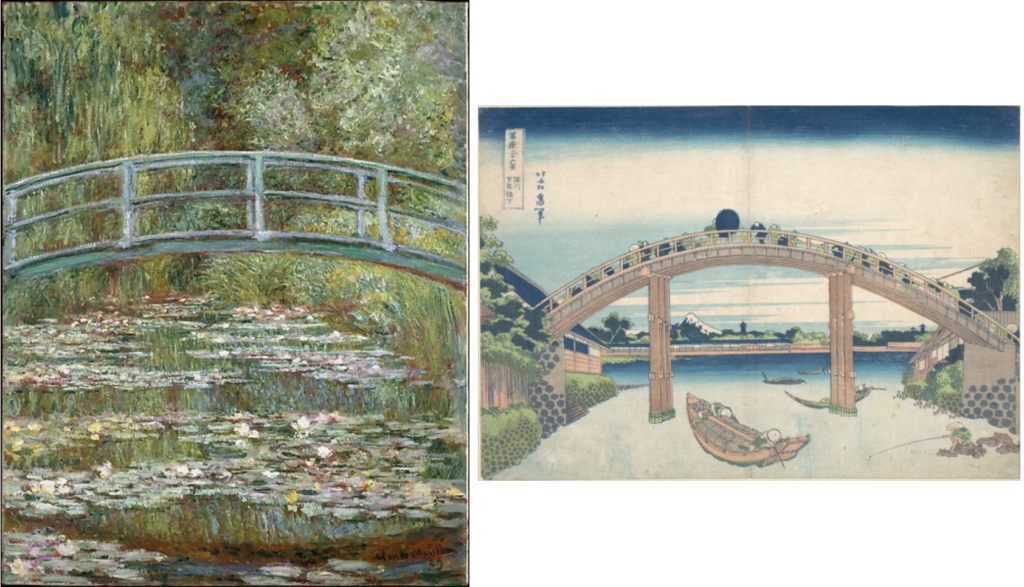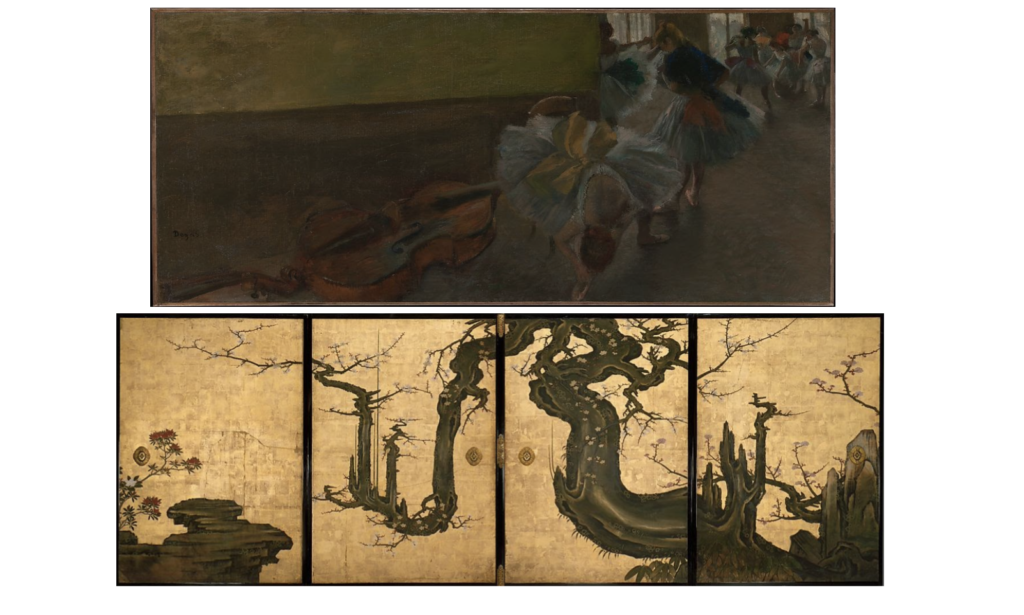By Hannah Smith
Overview:
The exhibition The Untold Story: Japan’s influence on Impressionism, details how the influx of Japanese artwork to the Western world in the 1850s, immensely inspired the “master” artists that are accredited for the Impressionist movement. I have personally been enchanted by the Impressionist movement for as long as I can remember. My earliest childhood memories consist of visiting the Metropolitan Museum of Art and marveling over the paintings of Edgar Degas, Claude Monet, and Vincent Van Gogh. The Impressionist movement was an artistic movement to capture everyday subject matter in a new way with vivid depictions of colors and visible brushstrokes. My love for Impressionism helped influence me to pursue a career in painting, and I often look towards this movement to inspire my own paintings.
The Impressionist movement came right after Japan’s re-opening up to the world in 1853, and more formally during the World’s Fair in 1867. The West became infatuated with all things Japanese, from Zen gardens to woodblock print. Naturally, this trickled into the evolving art scene and spurred the Impressionist movement. Impressionist artists, as accredited as some of the world’s artistic geniuses, all gravitated towards various Japanese artworks to seek their inspiration. While it’s natural for all artists to be inspired by a variety of subjects, I wondered where was the credit for this source of inspiration? If it was so easy to uncover these artists’ documented inspiration from Japanese artists, why isn’t it a part of the conversation when discussing the Impressionist movement in various educational settings?
The canon of art history is saturated with predominantly Western, white, male artists. I’m personally interested to challenge this narrative by showing how art and various artistic movements are not partial, but rather complex stories with diverse sources of inspiration. This exhibition is just one example of how one of the world’s most famous artistic movements centered in Europe, Impressionism was really a Western response to the artwork that had been created in Japan for hundreds of years prior. Composition, subject matter, color palette all are partial, if not entirely sourced from various woodblock prints or Japanese paintings.

Title: Women Bathing
Artist: Mary Cassatt
Date: c. 1890 – 91
Movement: Impressionism
Medium: Drypoint and aquatint, printed in color from three plates, fourth state of four (Mathews & Shapiro)
Size: 14 5/16 × 10 9/16 in
36.4 × 26.8 cm
Collection: Metropolitan Museum of Art
(Left)
Creator : Utagawa Toyokuni I
Title: Woman Washing Her Neck
Work Type: Woodblock Print
Date: c. 1812
Material: Woodblock Print, Ink and color on paper
Measurements: 27.9 x 25.6 cm
Repository: Museum of Fine Arts Boston
Subject: Woman bathing
Collection: William Sturgis Bigelow Collection
ID Number: 11.13638
Source: https://collections.mfa.org/objects/211202
https://www.vice.com/en/article/bjxpev/woodblock-prints-illustrate-history-sensuality-japanese-baths
https://www.roningallery.com/exhibitions/After-the-Bath
Comparison:
These two prints of women engaging in the everyday activity of bathing, help create a narrative of representation and visibility of women in the art history cannon. The strong compositional similarites of the candid and curved figures and naturalitic color palette strengthen the bond of inspiration Japanese woodblock prints had on Impressionist artists.
Mary Cassatt’s etching print shows a woman leaning over a sink washing herself. The image captures the moment, which is natural and unposed. The figure bends over with a bare rounded back and dresses draped down towards her waist. The color pallet is earthly with green, blue, and yellow washes that create a painterly-like quality to an etching print. The incorporation of florals found through the carpet and water pitcher, seems like a nod towards Japanese influence, as this imagery is classically found in woodblock prints of women to symbolize beauty, hope, and new life.
Mary Cassatt was influenced by various woodblock prints, particularly because of their incorporation of the female subject in everyday life. As a female artist herself, Mary Cassatt was drawn to the way the ukiyo-e prints showed women doing mundane activities and wanted to follow this tradition her own work.
Utagawa Toyokuni I’s print shows a beautiful woman washing over a small wooden tub. The gesture of the woman is natural and unbothered, with her head tilted to one side to scrub the back of her neck creating wonderful curves throughout the body. She holds a Prussian blue printed cloth for scrubbing herself, between dainty fingers. The woman’s black hair is pinned up with a golden hair comb. The swirled hairstyle creates the illusion of glistening hair from thin white brushstrokes among the stark black hair. Her skin is pale and is differentiated by the hue of the paper only by the black outline of the body. Her kimono is draped at her waist, exposing her bare chest for bathing.
The color pallet used is primarily earth-toned with browns, reds, and greens. Intricate details are shown within the geometric pattern of the kimono and details of rippling water in the tub. The composition reflects the sentiment of capturing the moment, with both the small wooden tub and kimono continuing off the page as if the viewer of this print is catching a quick glimpse of the scene. This bathing scene takes place under a blooming cherry blossom flower, symbolizing beauty, hope, and new life. The incorporation of this blooming branch also connects the woman with overarching Japanese themes of nature’s presence in all aspects of life.
This print continues the long tradition of bathing depicted in Japanese woodblock prints. Scenes of bathhouses, outdoor onsen (hot spring), or personal baths are all done to show their cultural tradition in Japan.

Title: Bridge over a Pond of Water Lilies
Artist: Claude Monet
Date: c. 1899
Movement: Impressionism
Medium: Oil on canvas
Size: 36 ½ x 29 in.
Collection: H. O. Havemeyer Collection, Bequest of Mrs. H. O. Havemeyer 1929
Metropolitan Museum of Art
(Left)
Title: Under the Mannen Bridge at Fukagawa, from the series Thirty-six Views of Mount Fuji
Artist: Katsushika Hokusai
Date: c. 1830-32
Movement: Edo Period
Medium: Woodblock Print, Ink and color on paper
Size: 10 ⅛ x 15 3/16
Collection: Rogers Fund, 1922
Metropolitan Museum of Art
Comparison:
Monet’s depiction of his Japanese style garden, is articulated throughout the active brushstrokes and vivid colors in this oil painting. In the mist of chaotic growth and playful reflections, the visual ancor of this work is the moon bridge. The moon bridge, which creates the “crescent moon” shape in the reflection of the water, links the French painter to Japanese inspiration through the architectural landscape. The very active reflection in the water of both the moon bridge and an explosion of growth from the garden, pay homage to different Hokusai prints.
Monet has been noted to have been inspiration from Hokusai by creating a series of works called Eighteen Views of the Wooden Footbridge, directly connecting to Thirty-six views of Mount Fuji.
Hokusai’s print shows off the impressive Mannen Bridge, which so wonderfully frames the Japanese landscape. This type of bridge is called a moon bridge and is meant to create the effect of a circular moon by the reflection in a body of still water. We can notice Mount Fuji tucked away in the background and placed asymmetrically between the pillars of the bridge. The color palette is analogous with rich Prussian blues, sap green, and burn Sienna browns. There are various fishermen incorporated in the scene, one notably in the foreground on a curved ship that play in relation with the arches in the bridge.

Title: Dancers in the Rehearsal Room with a Double Bass
Artist: Edgar Degas
Date: ca. 1882 – 85
Movement: Impressionism
Medium: Oil on Canvas
Size: 15 ⅜ x 35 ¼
Collection: H.O Havemeyer Collection, Bequest of Mrs. H. O. Havemeyer, 1929
Metropolitan Museum of Art
(Bottom)
Title: Old Plum
Artist: Kano Sansetsu
Date: c. 1646
Movement: Edo Period
Medium: Four Sliding-door panels; ink, color, gold, and gold leaf on paper
Size: Overall (of all four panels): 68 3/4 x 191 1/8 in. (174.6 x 485.5 cm)
Collection: The Harry G. C. Packard Collection of Asian Art, Gift of Harry G. C. Packard, and Purchase, Fletcher, Rogers, Harris Brisbane Dick, and Louis V. Bell Funds, Joseph Pulitzer Bequest, and The Annenberg Fund Inc. Gift, 1975
Metropolitan Museum of Art
Comparison:
These two masterful works depict very different subject matters; yet, create a similar experience of reading the work in an asymmetrical fashion.
Dagas was known to be one of the first collectors of Japanese artwork among his Impressionist peers, leading to redical changes in his own work. This particular oil painting continues Degas’ fond subject of the ballet dancers; Yet, shows radical change in composition from previous works. Degas decided to draw from Japanese artist’s innovative compositions, rather than their subject matter. Asymetric, arial, and elongated compositions started to be incorporated in Degas work in the late 1880s.
Kanso’s masterpiece of an aged and twisting plum tree painted on two door panels, shows an innovative way to create an image in a horizontal space. The glow of the gold leaf contrasted with the umber tones of the tree bark, create an interesting illusion of there being something magical or changing in the atmospher of the painting. Small blossoms delicately painted on the aged tree give indication of re-birth and re-newal after a winter season.
References:
IMAGES:
- “La Japonaise (Camille Monet in Japanese Costume).” Museum of Fine Arts Boston. Accessed November 14, 2021. https://collections.mfa.org/objects/33556/la-japonaise-camille-monet-in-japanese-costume?ctx=9bb8d5e7-2adc-4739-a597-b943cb19b6ce&idx=9.
- “Dancers in the Rehearsal Room with a Double Bass.” Metropolitan Museum of Art. Accessed November 14, 2021.
https://www.metmuseum.org/art/collection/search/436138?searchField=All&sortBy=Relevance&ft=Dancers+in+the+Rehearsal+Room+with+a+Double+Bass&offset=0&rpp=20&pos=1 - “Mary Cassatt: Woman Bathing (La Toilette) (1890–1891).” Artsy. Accessed November 11, 2021. https://www.artsy.net/artwork/mary-cassatt-woman-bathing-la-toilette
- “Old Plum.” Metmuseum.org. Metropolitan Museum of Art. Accessed November 28, 2021. https://www.metmuseum.org/art/collection/search/44858
- “Azaleas: Woman Washing her Neck.” Untitled series of Beauties and flowers. Museum of Fine Arts, Boston. Accessed November 11, 2021. https://collections.mfa.org/objects/211202
- “Bridge over a Pond of Water Lilies.” Metmuseum.org. Metropolitan Museum of Art. Accessed November 11, 2021. https://www.metmuseum.org/art/collection/search/437127
- “Under the Mannen Bridge at Fukagawa (Fukagawa Mannenbashi Shita), from the Series Thirty-Six Views of Mount Fuji (Fugaku Sanjūrokkei).” Metmuseum.org. Metropolitan Museum of Art. Accessed November 11, 2021.
https://www.metmuseum.org/art/collection/search/55289
TEXTS:
- Ives, Colta. “Japonisme.” In Heilbrunn Timeline of Art History. New York: The Metropolitan Museum of Art, 2000–. http://www.metmuseum.org/toah/hd/jpon/hd_jpon.htm (October 2004)
- Tanaka, Hidemichi. “Cézanne and ‘Japonisme.’” Artibus et Historiae 22, no. 44 (2001): 201–20. https://doi.org/10.2307/1483720
- Dean, Martin. “7 Things You Need to Know about Japonisme.” Sothebys.com. Sotheby’s. February 20, 2019. https://www.sothebys.com/en/articles/7-things-you-need-to-know-about-japonisme
- “Moon Bridge.” Wikipedia. Wikimedia Foundation. October 15, 2021. https://en.wikipedia.org/wiki/Moon_bridge